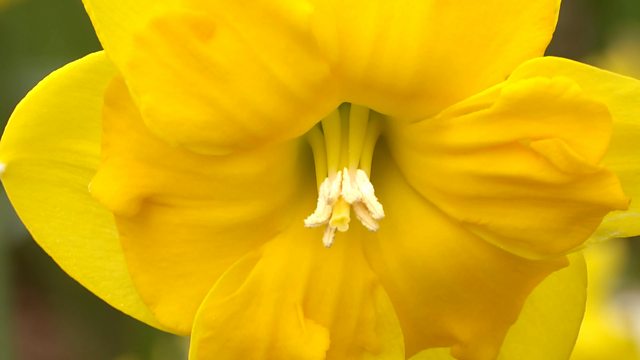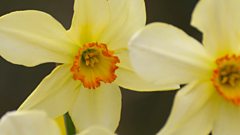
Episode 4
Gardening magazine. Carol Klein admires the daffodil. Monty Don pots up his dahlia tubers and offers tips for getting the best results later in the year.
Carol Klein continues to take a closer look at the nation's favourite plants and meets the people who dedicate their lives to them. This time she's admiring the daffodil.
Plus a visit to dahlia enthusiast Darren Everest on his allotment in Kent. He knows a thing or two about dahlias - he's been growing them, in all shapes and sizes, since he was just 11, and showing them, with great success, since he was a teenager.
In his own garden, Longmeadow, Monty Don pots up his own dahlia tubers, and offers tips for getting the best results later in the year.
And Joe Swift meets a Lancashire gardener who has spent 20 years creating a spectacular garden on a rocky cliff-face behind her home.
Last on
Clips
-
![]()
Cornish daffodil grower
Duration: 01:54
-
![]()
Lancashire rock garden
Duration: 03:32
Pruning overgrown climbers
Itâs all too easy for rampant climbers like honeysuckle to get out of control. Thereâs no harm in giving them a haircut now, but if you want to be more ruthless and chop them right back, you may lose a lot of this yearâs flowers. As a general rule, itâs best to prune immediately after flowering, but if you canât wait that long you could always prune half now and half later in the summer. The one time you shouldnât prune is in the winter, during really frosty weather. Good candidates for this type of pruning include:
- Clematis alpina
- Clematis armandii
- Clematis macropetala
- Clematis montana
- Jasminum nudiflorum (Winter jasmine)
- Jasminum officinale (Summer jasmine)
- Lonicera henryi
- Lonicera japonica (Japanese honeysuckle)
- Lonicera periclymenum (Common honeysuckle)
- Solanum crispum (Chilean potato tree)
- Solanum jasminoides (Potato vine)
(apps.rhs.org.uk)
Ron Scamp

Carol went to Falmouth in Cornwall to meet up with Ron Scamp - a legend in the world of daffodil breeding. She wandered through golden fields full of the 2,500 varieties that Ron grows, some of which heâs bred himself, while others are old, heritage varieties that he has saved. The mild climate and high light levels in Cornwall mean that his daffodils are about four weeks ahead of the rest of the country. Ronâs daffodil farm isnât open to the public, but over the coming weeks, he will be exhibiting at various flower shows including the RHS show in Cardiff.
(www.rhs.org.uk)
Dahlia allotment featured

Darren Everest has been growing dahlias since he was 11 and his whole allotment in Westerham in Kent is a blaze of colour when they are all in flower. His real interest lies in producing perfect blooms for the show bench and to stop earwigs from nibbling at the petals, he recommends smearing  petroleum jelly on the stem, just below each flower. For more great tips from Darren, check out the link below.
(www.darreneverestdahlias.co.uk)
Rock garden featured
Joe visited Glenn Shapiro in Lancashire to see how she copes with having nothing but rock to garden on. When she moved to Hazelwood Farm, she was determined to have a garden and although she loved the steep, limestone rock face that was there, she knew she had quite a challenge on her hands.Â
Even though she lives in an area of high rainfall, the rocks that support her garden filter and drain away any water as soon as it falls. Glenn uses soil-filled planting pockets wherever possible, and crams tiny seedlings and offsets into any spare crack or groove available. But the real secret of her success is the plants she chooses to grow. Here are some her favourites.
- Campanula rotundifolia (Common harebell)
- Dianthus deltoides (Maiden pink)
- Dryas octopetala (Mountain avens)
- Eryngium planum âBlue Hobbitâ (Sea holly)
- Phlox douglasii (Alpine phlox)
- Primula auricula (Auricula)
- Primula marginata (Silver-edged primrose)
- Pulsatilla vulgaris (Pasqueflower)
âThese all like full sun, but I would not like to be without Saxifraga cultivars among the shadier rocksâ says Glenn.
Glennâs garden is open for the National Gardens Scheme on Sun 8 June and Sun 3 August. For further details, click on the link below.
(www.ngs.org.uk)
Jobs for the weekend: Prune fig trees
Fig trees need to be grown against a warm, south-facing wall if you are to stand any chance of getting any fruit in this country. But to keep them within bounds, itâs worth giving them a prune every now and then. This lets in maximum sunlight and air which, in turn, helps to ripen the fruit. Prune out any crossing branches along with any dead or diseased twigs. The young embryonic figs are already in place - theyâre about the size of a pea at this stage - so donât prune too hard if you want a good crop this year.Â
(apps.rhs.org.uk)
Jobs for the weekend: Deadhead & feed amaryllis
Amaryllis make great presents and if you were given one for Christmas, donât throw it away! Thereâs a good chance it will flower again next year, given the right treatment. Cut off all the flower spikes once they have died, and start watering and feeding every fortnight. Long, glossy leaves will soon appear and it is these that will help to refuel the bulb. Itâs worth standing the pot outside in a sheltered spot, but wait until all danger of frost has gone.Â
(apps.rhs.org.uk)
Jobs for the weekend: Pot up dahlia tubers
If, like Monty, youâve been storing your dahlias over winter, now is the time to start them into growth. Check them over and discard any that have begun to rot or feel soft. Pot up the remainder using multipurpose compost and water sparingly. Place somewhere warm and light and, within a few weeks, shoots will start to sprout â a good source cutting material if you want several plants.
(apps.rhs.org.uk)
Credits
| Role | Contributor |
|---|---|
| Presenter | Monty Don |
| Presenter | Carol Klein |
| Presenter | Joe Swift |
| Series Producer | Christina Nutter |
| Series Editor | Liz Rumbold |
Broadcasts
- Fri 28 Mar 2014 21:00±«Óătv Two except Wales
- Sat 29 Mar 2014 19:30±«Óătv Two Wales
- Sun 30 Mar 2014 07:00
- Thu 10 Apr 2014 10:05
Featured in...
![]()
Gardeners' World
Gardening show packed with ideas and timely reminders to get the most out of your garden



